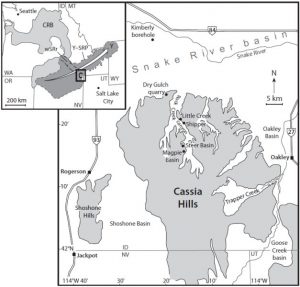
Ancient super-eruptions west of Yellowstone, USA, were investigated by an international initiative to examine the frequency of massive volcanic events. Yellowstone famously erupted cataclysmically in recent times, but these were just the latest of a longer succession of huge explosive eruptions that burned a track from Oregon eastward toward Yellowstone during the past 16 million years.
The Cassia Hills of southern Idaho preserve evidence of twelve catastrophic large-scale explosive eruptions, which left widespread glassy deposits fused to the landscape. Each deposit preserves subtly distinctive magnetic, mineralogical, and chemical characteristics that allow them to be traced great distances.
Painstaking work by Thomas R. Knott and colleagues has revealed records of previously undiscovered large-scale eruptions, which caused Earth’s crust in the area to subside by more than three kilometers, leaving a deep volcanic basin along the Snake River Plain. These older volcanic eruptions were hotter and probably more frequent than the Yellowstone eruptions.
Reference:
Thomas R. Knott, Michael J. Branney, Marc K. Reichow, David R. Finn, Robert S. Coe, Michael Storey, Dan Barfod, Michael McCurry. Mid-Miocene record of large-scale Snake River−type explosive volcanism and associated subsidence on the Yellowstone hotspot track: The Cassia Formation of Idaho, USA. Geological Society of America Bulletin, 2016; B31324.1 DOI: 10.1130/B31324.1
Note: The above post is reprinted from materials provided by Geological Society of America.










